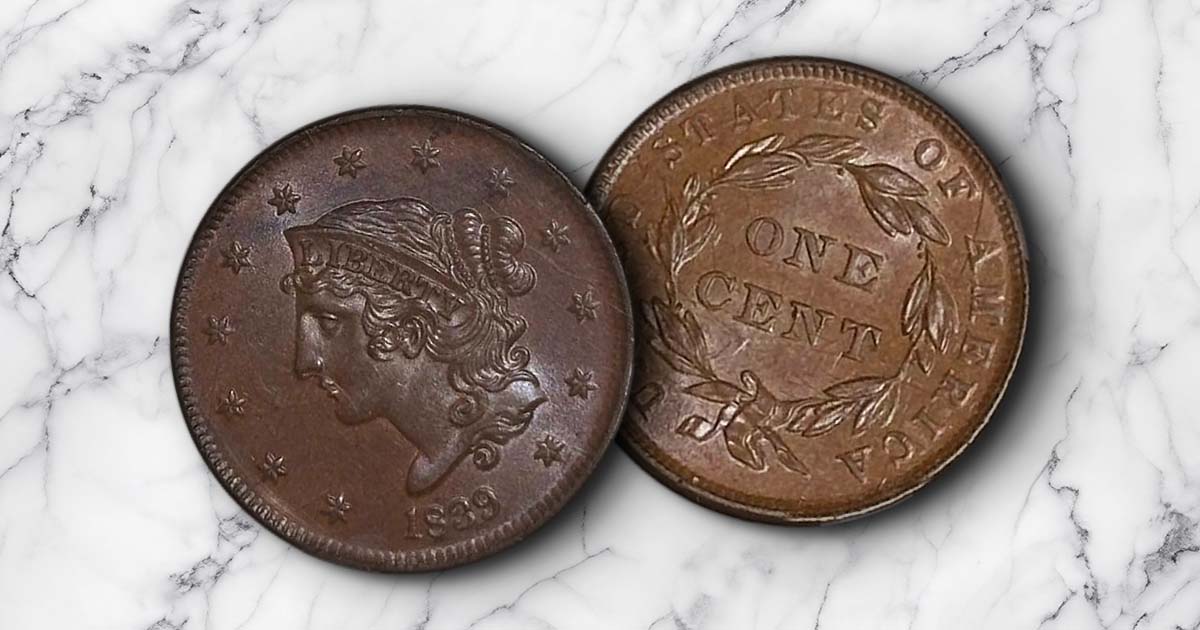
Booby Head is the name given to one of the varieties of the 1839 Braided Hair cent. This colorfully named large cent variety was one of four primary die varieties for the issue, which also included the Head of 1838, Silly Head, and Type of 1840 varieties. Additionally, there are multiple distinct die subsets of the Booby Head die variety.
Why are Some 1839 Braided Hair Cents Called Booby Heads?
The term Booby Head comes from the peculiar appearance on a variety of Braided Hair large cent issues. Liberty’s hair curls down around her shoulder, proceeding to curl up from underneath it. This results in a Liberty with an enlarged and awkward neck. Her posture appears to be tilting forward and her chin is slightly amiss, depicted smaller than other varieties. Due to these unusual and distinct renderings, the variety earned the colloquial nickname Booby Head. In this context, the word booby plays on the awkwardness like the seabird known as a booby, which is equally awkward.
How to Identify a Booby Head Braided Hair Large Cent
There are two things to look for if you are trying to determine if your Braided Hair large cent is a Booby Head variety.
- Examine the Reverse. One of the easiest ways to identify a Booby Head Braided Hair large cent is by assessing the reverse of the coin. If there is a line underneath the word CENT, it is probably a different variety of the Braided Hair issue. The Booby Head Braided Hair issues did not have a line underneath CENT on the reverse.
- Examine the Obverse.
- If there is a lock of hair beneath the crown, just above Liberty’s nose, the coin is either a Silly Head or a Booby Head variety. This can be further confirmed by the presence of a hair line that is slightly higher than the word LIBERTY on the crown.
- If there is a shoulder tip with hair curled beneath it that then emerges in an upward direction from the shoulder itself, this is a Booby Head variety. The Silly Head variety does not depict this anatomically inaccurate feature.
What Led to the Booby Head Issue?
Before the War of 1812, England supplied the United States Mint with copper blanks to produce pennies. Due to a trade embargo during the War of 1812, there were fewer than half as many pennies struck in 1813 or 1814 as in 1812. The 1814 Classic Head large cent had a mintage of only 357,830 coins, as the Mint ran out of copper planchets that year. For context, the 1812 issue of Classic Head large cents had a mintage of 1,075,500. There was no 1815-dated penny, although some were struck in December of 1815 using both 1814 and 1816 coin dies.
After lifting the embargo, the US Mint received copper planchets to resume striking cents, using the newly designed Coronet Head by Robert Scot instead of the Classic Head by John Reich. The Classic Head design was not well received and was often criticized. When the 1816 Coronet Head large cent was issued, it was heavily criticized. Some numismatists described it as a ‘spectacularly ugly head of Ms. Liberty.’
The Coronet Head large cent was redesigned by Christian Gobrecht. Gobrecht kept the primary design features but updated them to depict Liberty as more youthful and slimmer. Today, the Coronet Head is often referred to as the Matron Head, a nod to Liberty’s older appearance.
Is the Booby Head Variety Valuable?
While other die varieties of the 1839 Braided Hair large cent may be more valuable, the Booby Head variety is still valuable, especially in higher grades. It is estimated that about half of all 1839 Braided Hair large cents are of the Booby Head variety, although they are scarce in higher grades and Red/Brown varieties.




